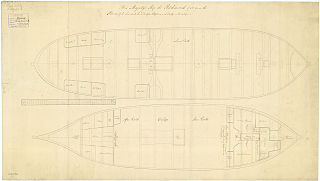Antony Preston was an English naval historian and editor, specialising in the area of 19th and 20th-century naval history and warship design.

HMS Lowestoffe was a 28-gun Lowestoffe-class sixth-rate frigate of the Royal Navy. Named after the UK's most easterly port of Lowestoft in Suffolk the ship was designed by Sir Thomas Slade based on the earlier Lyme of 1748, "with such alterations as may tend to the better stowing of men and carrying for guns." The design provided for a 24-gun ship of 583 tons, but on completion the ship measured some 11 tons more.
HMS Tweed was a 32-gun sailing frigate of the fifth rate produced for the Royal Navy. She was designed in 1757 by Sir Thomas Slade, based on the lines of the smaller sixth rate HMS Tartar, but with a 10-foot midsection inserted. She was built in Blaydes Yard in Kingston-Upon-Hull.

HMS Lark was a 32-gun Richmond-class frigate fifth-rate frigate of the Royal Navy. She was launched in 1762 and destroyed in Narragansett Bay in 1778, during the American Revolutionary War.

HMS Thisbe was a 28-gun Enterprise-class sixth-rate frigate of the Royal Navy.
Brian Lavery, is a British naval historian, author, and Curator Emeritus at the National Maritime Museum, Greenwich, London, England.

HMS Rose was a 28-gun Enterprise-class sixth-rate frigate of the Royal Navy. Rose was first commissioned in August 1783 under the command of Captain James Hawkins.
HMS Actaeon was a 28-gun Enterprise-class sixth-rate frigate of the Royal Navy.

HMS Cyclops was a 28-gun Enterprise-class sixth-rate frigate of the Royal Navy. The Cyclops was first commissioned in July 1779 under the command of Captain John Robinson.
HMS Laurel was a 28-gun Enterprise-class sixth-rate frigate of the Royal Navy. Laurel was first commissioned in October 1779 under the command of Captain Thomas Lloyd. She sailed for the Leeward Islands on 13 April 1780, but was wrecked on 11 October in the Great Hurricane of 1780 at Martinique. Lloyd, and all but 12 of his crew, died.

HMS Pomona was a 28-gun Enterprise-class sixth-rate frigate of the Royal Navy. Pomona was first commissioned in September 1778 under the command of Captain William Waldegrave.
HMS Andromeda was a 28-gun Enterprise-class sixth-rate frigate of the Royal Navy. Andromeda was first Royal Navy ship commissioned by that name, in September 1777 under the command of Captain Henry Byrne. On 30 May 1778 she captured and burned American privateer brig Angelica at sea while transporting General Sir William Howe back to England. It sank off Martinique in the Great Hurricane of 1780 on 11 October 1780, killing all of the crew.

HMS Mermaid was a Mermaid-class sixth-rate frigate of the Royal Navy. She was first commissioned in April 1761 under Captain George Watson and built in Blaydes Yard in Kingston-Upon-Hull.
HMS Greyhound was a modified Royal Navy Mermaid-class sixth-rate frigate. She was first commissioned in October 1775 under Captain Archibald Dickson.

HMS Boston was a 32-gun Richmond-class fifth-rate frigate of the Royal Navy. She was launched in 1762. She served during the American Revolutionary War and the French Revolutionary War, and was broken up in 1811.

HMS Juno was a 32-gun Richmond-class fifth-rate frigate of the Royal Navy. She was launched in 1757 and served throughout the American Revolutionary War until scuttled in 1778 to avoid capture. She engaged USS Providence during Providence's escape from Providence, Rhode Island 30 April 1778.

HMS Richmond was the name ship of the six-vessel, 32-gun Richmond-class fifth-rate frigates of the Royal Navy. She was launched in 1757 and served throughout the American Revolutionary War. She captured a prize in Chesapeake Bay in January, 1778 and 1 off Cape Charles in February, 1778. She was captured by the French 74-gun Bourgogne and the frigate Aigrette captured her on 11 September 1781 in the Chesapeake. She then served as Richemont under Lieutenant Mortemart.

HMS Hussar was a 28-gun Coventry-class sixth-rate frigate of the Royal Navy.

HMS Meadowsweet was a Flower-class corvette that served with the Royal Navy during the Second World War. She served as an ocean escort in the Battle of the Atlantic.











